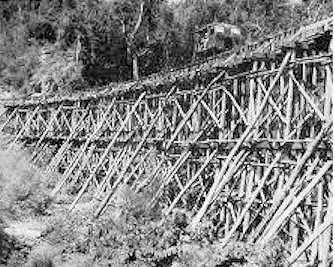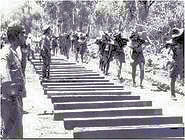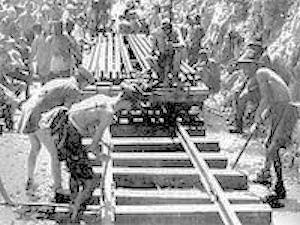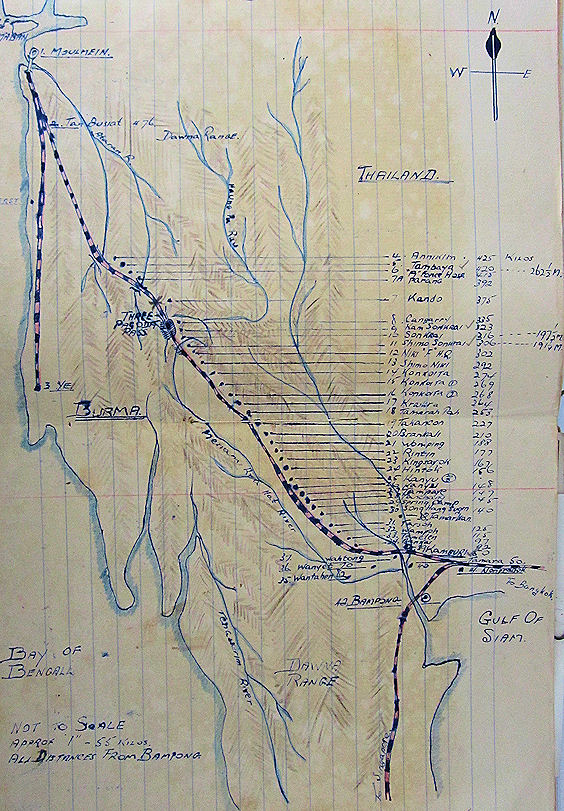Thai - Burma Death Railway
Historical Overview
Between 1942 and 1943, large numbers of prisoners were moved from Singapore and Java to various locations in Burma and Thailand. The Japanese planned to invade India. They needed to transport vital supplies and equipment to their troops as they marched north. It was decided that a railway would be built across Thailand and Burma, from Bampong to Thanbyuzayat.
The POWs were organised into several working parties consisting of from 2,000 to 12,000 workers at the railway headquarters at Kanburi. Two parties were sent to Thanbyuzayat in Burma and four were sent to Bampong in Thailand. The parties would begin construction on the ends of the railway and work towards the middle, creating a total railway line of 415 kilometres. Australian prisoners were used in the working parties at both ends of the line. The Japanese set a horrific pace. The deadline for construction was August 1943. Over 60,000 Allied prisoners worked the line. 12,000 were Australians. POWs were administered by 12,000 Japanese and 3,000 Korean soldiers. The work was difficult. Track had to be laid on an even surface. Before construction of the railway could begin, dense rainforest had to be cleared. Trees were felled, embankments were made. In October 1942, the work quota was 0.6 cubic metres of earth each day for each man. There was a ten minute rest period every hour. Australian soldiers completed their work quickly. The Japanese cracked down on their efficiency by doubling their quota.
Australian soldiers were forced to move two cubic metres of earth, regardless of their level of health, size, or physical capabilities. They were given no tools and were usually without shoes or clothes, other than underpants, swimming trunks or handmade loin cloths.
 |
 |
The railway was frequently bombed by Allied aircraft. The Allies were not aware that the Japanese were using European, American and Australian POWs to construct the railway.
The Japanese set a cracking pace by working prisoners in shifts of 24 hours on and off. Men who were sick with tropical diseases were forced to work as long and as hard as healthy men. As food quality declined, the death rate rose, and the Japanese pushed the workers ever harder in 33-hour shifts. The food, living conditions and health care were poor and often non-existent. Food was difficult to obtain. Prisoners survived on rice and whatever protein they could find. Boxed meat was sent in. It was often half-rotten and covered with flies. Cattle was sent along the railway line but they were small, undernourished, and often diseased. The rotten meat would be cut away, maggots washed off, flies shooed. The meat was then eaten. Most men lost one-third of their body weight and slowly starved to death. They were working on fewer than 2,000 calories on 24-hour shifts. The few doctors who were in the prison camps deemed one in three men unfit for work. This meant little to the Japanese and Korean prison wardens.
Living conditions were no match for the harsh environment. In June 1943, the monsoonal rains arrived. Clothes rotted, shoes fell apart, latrines overflowed. Flies bred and maggots were found everywhere. Rotting bodies of the dead or diseased lay in open or shallow graves and the rain brought their filth to the surface, spilling into the shelters of the prisoners.
The almost constant rain, heat, and humidity was a breeding ground for a host of tropical diseases. Many prisoners suffered from a lack of vitamin B, found in such foods as wheat and meat. Deficiency in vitamin B eventually developed into beriberi. Prisoners with beriberi found their feet and legs swelling. In severe cases, the entire body bloated.
The bloating was caused by an excess of water stored in the body as it could not be expelled.
To counteract the problem, prisoners often ate native plants they found while working on the railway. Often, though, there was not enough vitamin B in these plants to stop the eventual bloating that would take their lives. Malaria took its toll on prisoners. The body suffered from violent attacks of shivering, heavy sweating, hallucinations, nausea, vomiting, diarrhoea, and headaches. If a prisoner caught malaria he could suffer from up to 30 attacks. Cuts and wounds could not heal in the humid environment. Tropical ulcers could develop into gangrene, leading to certain death. There were no bandages or medicine to clean wounds. Prisoners would use a spoon to scrape out the pus and bleed the infection out. Other options included standing in the creeks and rivers and allowing fish to eat away at the dead flesh, or scooping the plentiful maggots from rotting food and applying them to the dead flesh.
If the infection did not go away, gangrene could develop. The only remedy for gangrene was amputation. Given the awful conditions in which the prisoners lived, this often meant death.
Dysentery and diarrhoea, the loss of bowel control, was a common condition for prisoners of war. Flies could transmit the bacteria which lodged itself deep in the bowel. Constant diarrhoea led to dehydration and exhaustion which then made prisoners susceptible to a host of other diseases.
 |
 |
To counteract the effects of dysentery, prisoners would grind small pieces of charcoal into their rice and eat it. Charcoal was often used to help ease the discomfort of digestive illnesses. Dysentery, like malaria, was not easily cured. Many prisoners of war died from dysentery after the war was over. Cholera was also a major killer. Flies ate human faeces and infected humans with the bacteria through eating utensils and food. The bacteria also contaminated the water supplies when faeces were washed into creeks by the monsoonal rains. Cholera symptoms included vomiting and diarrhoea, excreting a milky fluid. There was sudden weight loss and exhaustion. Dehydration set in and without proper medical treatment most victims died. There were some Allied doctors operating on the Burma - Thailand railway but they were hindered by poor medical facilities, hygiene, and a severe lack of equipment and drugs. They often heroically protected the sick and dying from the guards who scraped the bottom of the labour barrel for workers. The doctors were punished if they could not provide 85 per cent of men to work. Most horrifying of all was the brutal treatment experienced by the prisoners at the hands of their Japanese and Korean captors. The guards were not disciplined by their superiors and were free to beat the soldiers with whatever implements they had at hand, including rifle butts, shovels, bamboo poles and crowbars.
The prisoners were hit anywhere and everywhere - in the groin, on ulcers and wounds, broken bones, faces, necks, backs. They were beaten for often minor infractions. After they were beaten, some guards forced the prisoners to stand at attention for several hours, even days. Sometimes prisoners were forced to hold up heavy weights, like pails of waters, on their outstretched arms. They were beaten if their arms relaxed, if they sagged under the pressure, or spilled water from the pails. The Japanese guards often punished the sick and injured as a deterrent to falling ill in the first place. Australians suffered the lowest death rate of the other prisoners on the Burma - Thailand railway. When the prisoners completed the railway, they were evacuated to Singapore.
Of the 12,000 Australian prisoners who were taken to the Burma - Thailand railway, 2,646 died of starvation, disease, exhaustion, and brutality. Of the 270,000 conscripted Asians, many Indonesian prisoners of war, who worked on the line, at least 70,000 died. Japanese and Korean guard brutality knew no distinction between race, age, rank, or nationality.
Thailand - Burma Railway - Hand Drawn Map
There have been many maps drawn of the "death railway" and many interpretations of the names of towns, villages and forced work camps along the line. This is Bob Kelsey's map drawn when back in Changi and copied from his diary - the pencil ticks (3 in number) indicate where he worked:

